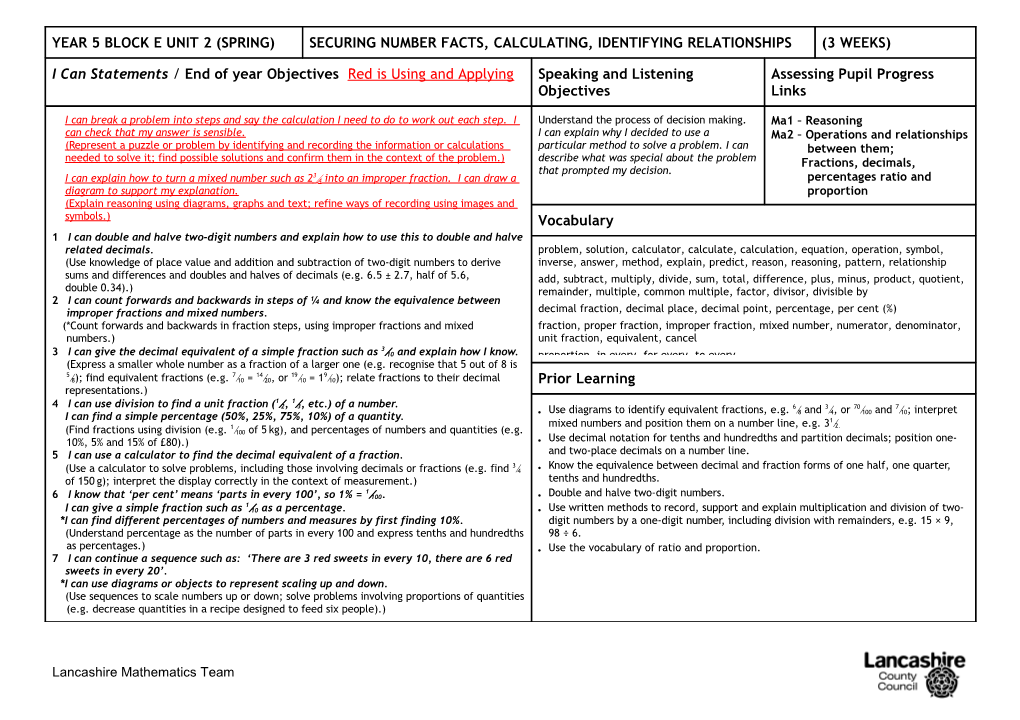YEAR 5 BLOCK E UNIT 2 (SPRING) / SECURING NUMBER FACTS, CALCULATING, IDENTIFYING RELATIONSHIPS / (3 WEEKS)
I Can Statements / End of year Objectives Red is Using and Applying / Speaking and Listening Objectives / Assessing Pupil Progress Links
I can break a problem into steps and say the calculation I need to do to work out each step. I
can check that my answer is sensible.
(Represent a puzzle or problem by identifying and recording the information or calculations
needed to solve it; find possible solutions and confirm them in the context of the problem.)
I can explain how to turn a mixed number such as 23¤4 into an improper fraction. I can draw a
diagram to support my explanation.
(Explain reasoning using diagrams, graphs and text; refine ways of recording using images and
symbols.)
1 I can double and halve two-digit numbers and explain how to use this to double and halve
related decimals.
(Use knowledge of place value and addition and subtraction of two-digit numbers to derive
sums and differences and doubles and halves of decimals (e.g. 6.5 ± 2.7, half of 5.6,
double 0.34).)
2 I can count forwards and backwards in steps of ¼ and know the equivalence between improper fractions and mixed numbers.
(*Count forwards and backwards in fraction steps, using improper fractions and mixed numbers.)
3 I can give the decimal equivalent of a simple fraction such as 3¤10 and explain how I know. (Express a smaller whole number as a fraction of a larger one (e.g. recognise that 5 out of 8 is 5¤8); find equivalent fractions (e.g. 7¤10=14¤20, or 19¤10=19¤10); relate fractions to their decimal
representations.)
4 I can use division to find a unit fraction (1¤2, 1¤3, etc.) of a number.
I can find a simple percentage (50%, 25%, 75%, 10%) of a quantity.
(Find fractions using division (e.g. 1¤100 of 5kg), and percentages of numbers and quantities (e.g. 10%, 5% and 15% of £80).)
5 I can use a calculator to find the decimal equivalent of a fraction.
(Use a calculator to solve problems, including those involving decimals or fractions (e.g. find 3¤4
of 150g); interpret the display correctly in the context of measurement.)
6 I know that ‘per cent’ means ‘parts in every 100’, so 1%=1¤100.
I can give a simple fraction such as 1¤10 as a percentage.
*I can find different percentages of numbers and measures by first finding 10%.
(Understand percentage as the number of parts in every 100 and express tenths and hundredths as percentages.)
7 I can continue a sequence such as: ‘There are 3 red sweets in every 10, there are 6 red
sweets in every 20’.
*I can use diagrams or objects to represent scaling up and down.
(Use sequences to scale numbers up or down; solve problems involving proportions of quantities (e.g. decrease quantities in a recipe designed to feed six people).) / Understand the process of decision making.
I can explain why I decided to use a particular method to solve a problem. I can describe what was special about the problem that prompted my decision. / Ma1 – Reasoning
Ma2 – Operations and relationships between them;
Fractions, decimals, percentages ratio and proportion
Vocabulary
problem, solution, calculator, calculate, calculation, equation, operation, symbol, inverse, answer, method, explain, predict, reason, reasoning, pattern, relationship
add, subtract, multiply, divide, sum, total, difference, plus, minus, product, quotient, remainder, multiple, common multiple, factor, divisor, divisible by
decimal fraction, decimal place, decimal point, percentage, per cent (%)
fraction, proper fraction, improper fraction, mixed number, numerator, denominator, unit fraction, equivalent, cancel
proportion, in every, for every, to every
Prior Learning
· Use diagrams to identify equivalent fractions, e.g. 6¤8 and 3¤4, or 70¤100 and 7¤10; interpret mixed numbers and position them on a number line, e.g. 31¤2.
· Use decimal notation for tenths and hundredths and partition decimals; position one- and two-place decimals on a number line.
· Know the equivalence between decimal and fraction forms of one half, one quarter, tenths and hundredths.
· Double and halve two-digit numbers.
· Use written methods to record, support and explain multiplication and division of two-digit numbers by a one-digit number, including division with remainders, e.g.15×9, 98÷6.
· Use the vocabulary of ratio and proportion.
Year 5 Block a Unit 1 (Autumn)
